Bee Balms are one of the more popular natives that is actually sold in nurseries around America. Well, at least cultivars of it are…but if you are a bit more adventurous and want to stand out at your local gardening club, why not grow a more rare form of bee balm?

White Bee Balm is a perennial native to North America[1]. Scientifically known as Monarda clinopodia, it typically grows 1-4′ tall in full sun to part shade and moist to medium-moist soil. Blooming unique white flowers for four weeks in Spring/Summer[2], it attracts numerous pollinators including bees, butterflies, and hummingbird[3].
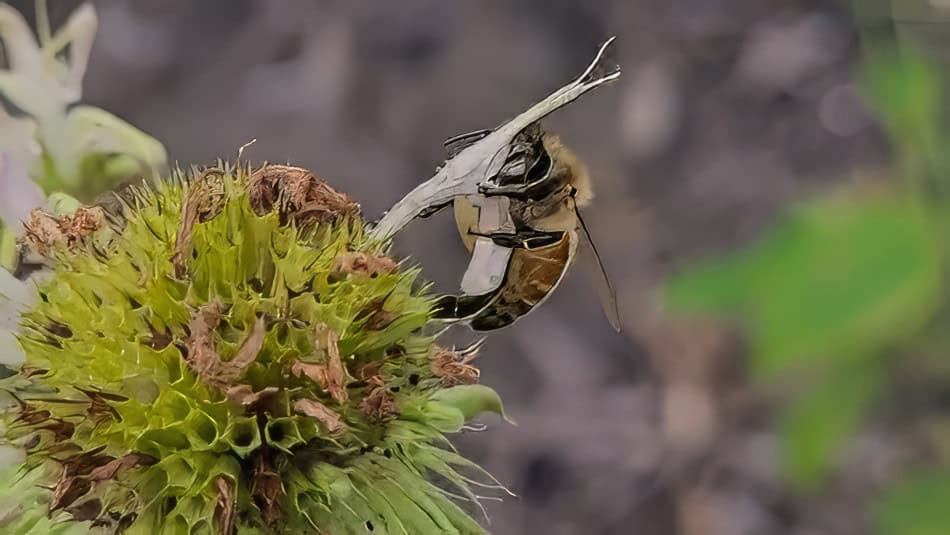
I first learned of this plant several years ago, and I instantly wanted to get it. The trouble is, it is hard to find. While many nurseries, even big-box stores carry some version of bee balm, the straight species of the white is almost never found even at specialty nurseries that primarily deal in natives. Heck you will even have a very difficult time buying seed for it!
But, I was lucky enough to come across some in the wild. And I collected a couple seed heads about a month after blooming (only take <10% of the seed heads, and make sure you are allowed to do so!). I was able to germinate a large number of seeds via winter sowing. Now I have my own ‘seed bank’ and source that I am happily going to spread to the woods behind my home, hoping that this deer-resistant native can outcompete Japanese Stiltgrass over time.
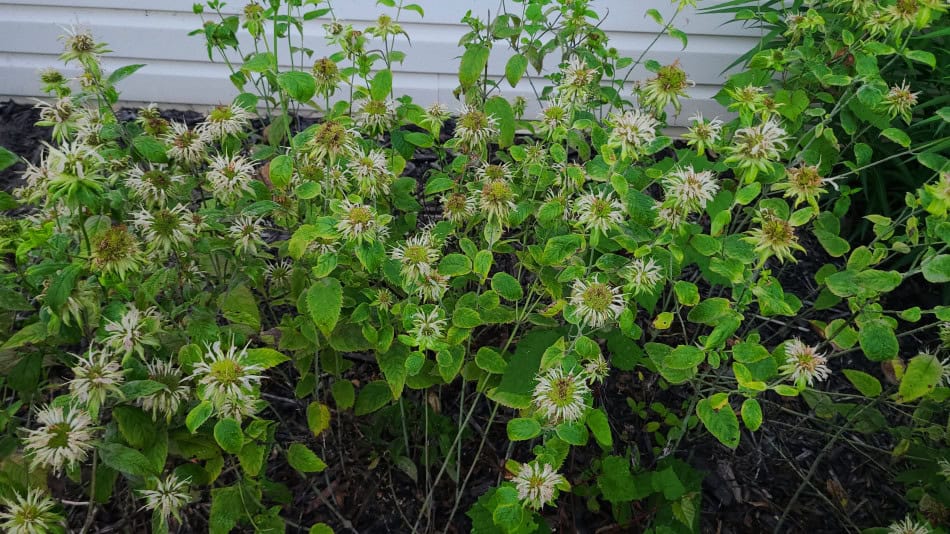
Now, this plant, like some other bee balms is a spreader! Some references may tell you to ‘give it room’, but that is quite frankly BS. The rhizomes of this plant will spread far and wide if allowed. So, you need to either be prepared to prune back rhizomes in Spring (I spend less than 30 min) or take special steps to contain it. See my guide to controlling rhizome plants here, and for what it is worth I have successfully done this on Red Bee Balm.
Native Range
The primary native range of White Bee Balm is in the Appalachian mountains[1]. But it also covers some isolated areas of the Midwest, notably Illinois and Michigan. It is listed as rare or endangered in several states including Missouri[4].
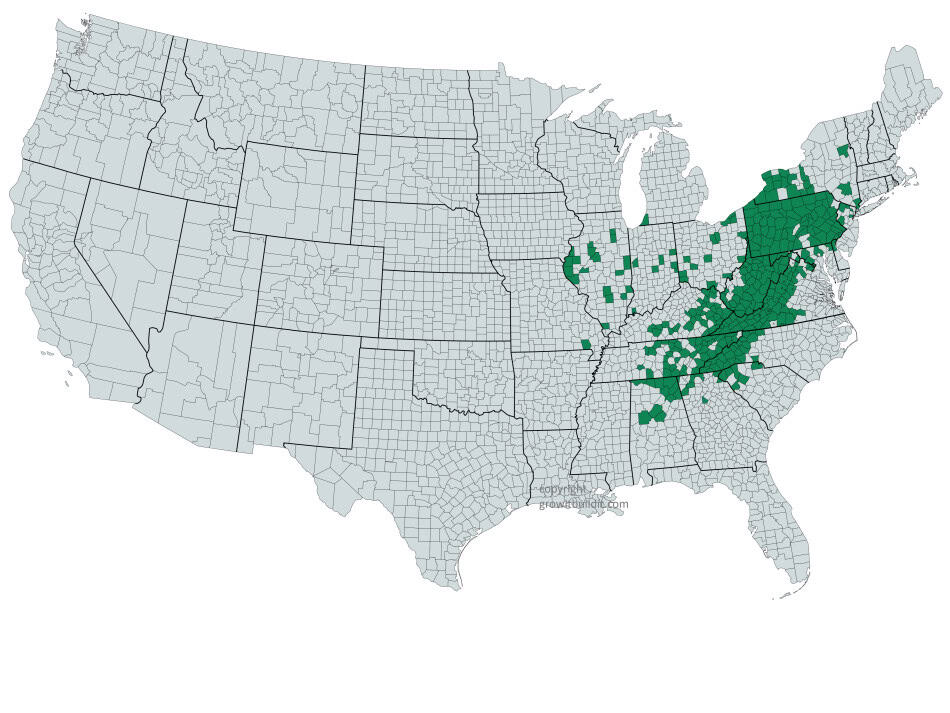
Reference Table
| Scientific Name | Monarda clinopodia |
| Common Name(s) | White Bee Balm, White Bergamot |
| Native Range, USDA Zone | Central and Eastern United States, USDA Gardening zones 5-8 |
| Bloom Time | Late Spring, early Summer |
| Bloom Duration, Color | 4 weeks, white |
| Height | 2-6′ |
| Spacing / Spread | 1-2′ |
| Light Requirements | Full sun to part shade |
| Soil Types | Sandy to clay, well-drained |
| Moisture | moist to medium |
| Fauna Associations / Larval Hosts | Bees, butterflies, hummingbirds |
Benefits
Beauty
This plant, like all Bee Balms is beautiful. The flowerhead structure and shape of Beebalms and Bergamots is incredibly unique, almost seeming like some exotic tropical or alien plant.
Wildlife
This flower is a pollinator favorite. I regularly see numerous species of bees mobbing mine in my front native plant flower bed, but also see butterflies. Hummingbirds are also reported to love this plant, although I haven’t captured one visiting mine – yet!

Understory plant
This beebalm is unique in that it can grow in part shade. So, when it comes to the forest understory, this one can often manage to survive. The first time I saw this plant it was in a somewhat deep forest surrounded by tall mature Walnuts and Oaks. Yet here was this conspicuous white flower growing near a creek.
Identification and Characteristics
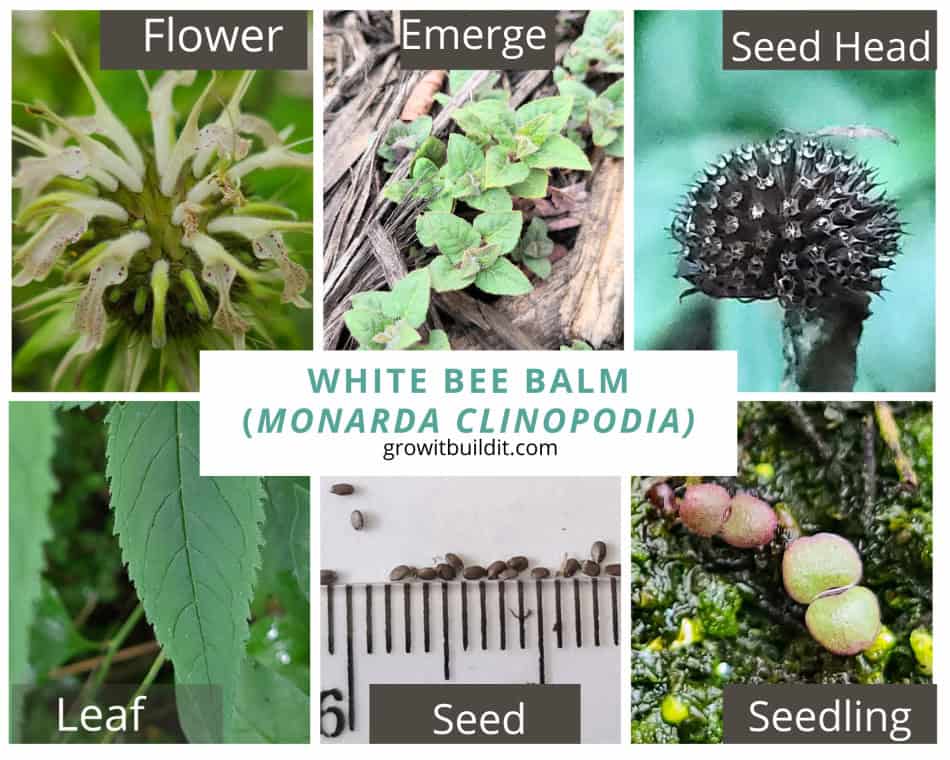
Stalk
This is a member of the mint family, and as such will have a square stem and is largely glabourus. Some references list the overall plant as growing upwards of 6′ tall, however I have some growing in full sun and they are at most 30″ tall. So I am a bit skeptical of this, and the ones I encountered in the wild I would estimate as 18-24″.

Leaf
Opposite pairs of simple leaves are 3-6″ long by 1/3 as wide and ovate to lanceolate in shape[2]. Margins are serrated and ciliate. Each pair will be rotated 90 degrees from the previous one along the stem. The margins are serrated and ciliate. For color, it will typically be a dark green and have a strong aroma when crushed.
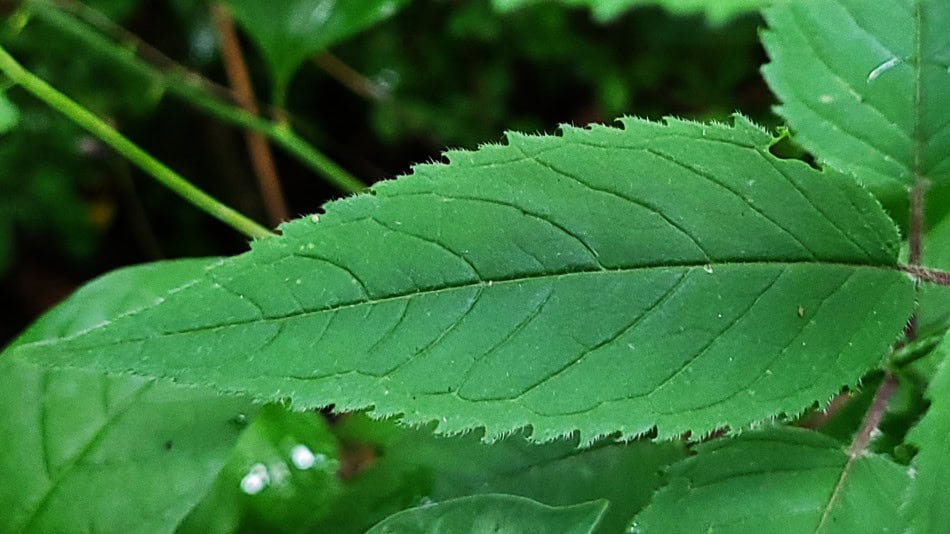

Flower
Overall flowerheads are about 2″ wide. The flowerhead will have numerous tubular flowers that are white or cream-colored, sometimes with small purple speckles. The center flowers will begin blooming first, and slowly work there way to the outside diameter in about 4 weeks. Blooming occurs in late Spring to Summer, lasting roughly a month. Below the flowerhead will eb bracts that can be green or white in appearance.

Root
The root system is rhizomatous, and will spread.
Growing Conditions
This plant is pretty adaptable in the locations it can grow. I’ve seen it growing best in places where it can receive some afternoon shade, which helps prevent the plant from drying out. But it seems to do best in rich, well-drained soils with plenty of organic matter. In natural settings it grows well in situations similar to red bee balm, along forest edges, near water (but not in it), and in the bottom of ditches.
| Growing condition | |
|---|---|
| Sunlight | Full sun to part-shade |
| Soil texture | Clay to sandy loam – must be well-drained |
| Soil moisture | Moist to medium |
Saving seed from White Bee Balm
You can easily save seed from this plant. Contrary to other species of Bee Balm, the seed heads of White Bee Balm hold the seed well. Now, I’ve written up a very detailed guide on this process but will give you the cliff-notes here.

About four weeks after blooming, go to the plants and examine the flower heads. If they look brown and dried out, pinch or cut them off and place into a baggy, taking care to keep the head upright as the seed may spill out if turned sideways or upside down. Place the seedheads in a cool dry place for about a week to dry out any surface moisture, then place into a large container with a lid. Vigorously shake the container to release the seed.
Pass the seed/chaff through a kitchen strainer (optional) to remove the chaff. Store the dried seed in a zip-lock bag for up to two years. I really don’t know how long the seed is viable, but as it ages the vitality will decrease.
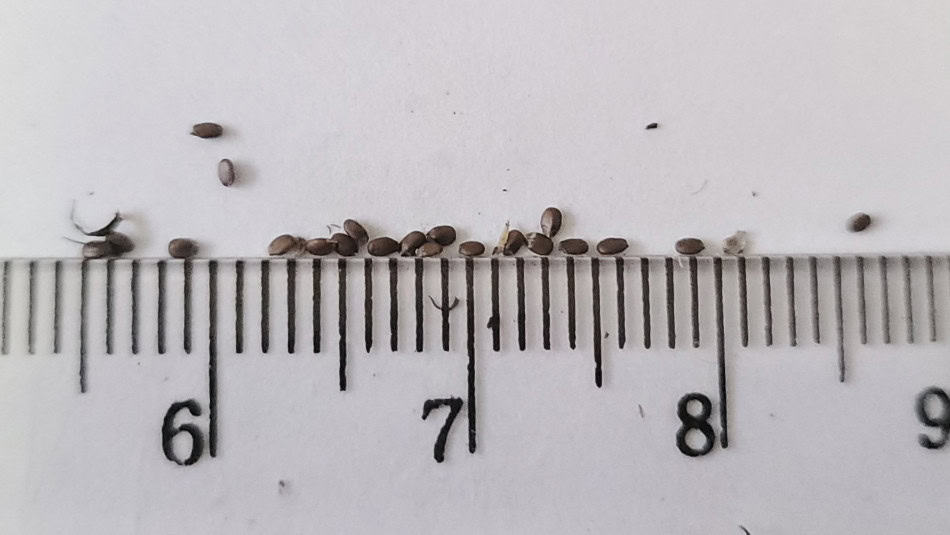
How to Grow White Bee Balm from Seed
White Bee Balm seed has a cold-moist stratification requirement of approximately 21 days[5]. You can achieve this by cold-moist stratifying in the fridge using a paper towel and zip-lock bag, or by winter sowing. All things equal, winter sowing is by far the easiest method to germinate the seed, as there is no fungus risk and the plant will naturally germinate in Spring.
Planting instructions
For stratified seed or winter sowing, simply fill a suitable container with moist potting soil. Sprinkle the seed on top and press it in with your thumb taking care not to cover it. Place the container in a location that gets morning sun and afternoon shade, and germination should occur within a couple of weeks after temperatures begin to warm up. Make sure you only water by misting so you don’t wash the seed away.
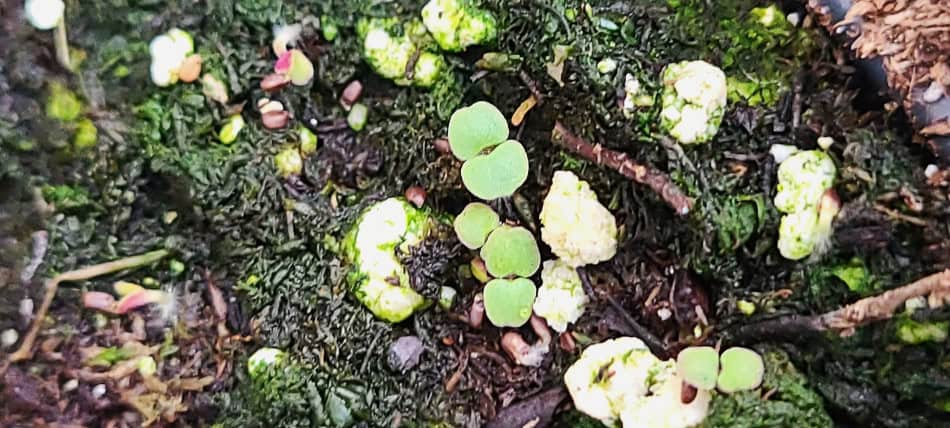
And for what it is worth, I prefer to winter sow between Christmas and New Years, as it just seems to be the easiest way to make sure the plants get cold stratification.
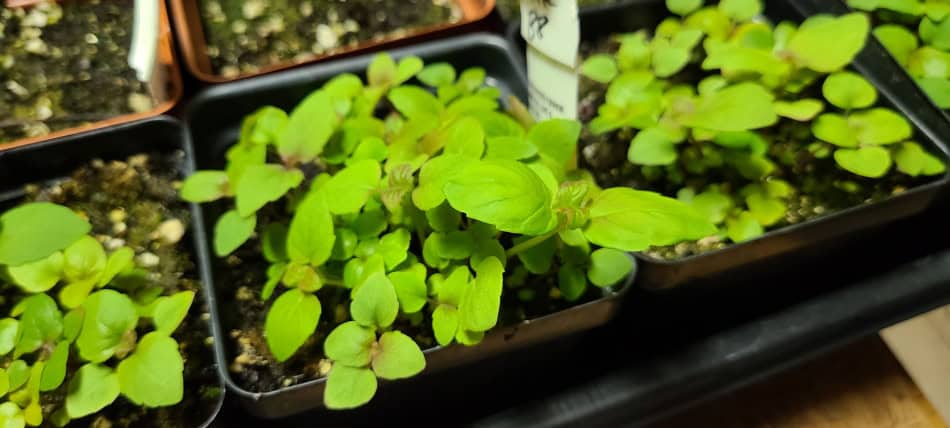
Direct sowing
It should be possible to direct sow the seed too. Simply scatter the seed in a disturbed area with suitable growing conditions, and walk on it to make sure it has good contact with the soil. Do this in Autumn after the leaf litter is down. You should get some seedlings come Spring.
Propagating by division
You can easily divide this plant in Spring. When you see the plant emerge, carefully dig up the sprout/shoot. Cut the shoot a few inches beyond the sprout you wish to separate, and then pot it up or replant in a new location immediately.
Spring is the best time to do this. The soil is cool and moist, which means the plant will not dry out nor experience much heat stress or transplant shock. I’ve had 100% success doing this before May in zone 6/7.

Wildlife, Pests, and Diseases associated with White Bee Balm
Pollinators
This plant does great at attracting pollinators – mostly bees, but also butterflies and hummingbirds[3]. I’ve noticed a variety of insects that I’m currently unable to identify, so I suspect that it is even more popular than what the references say!
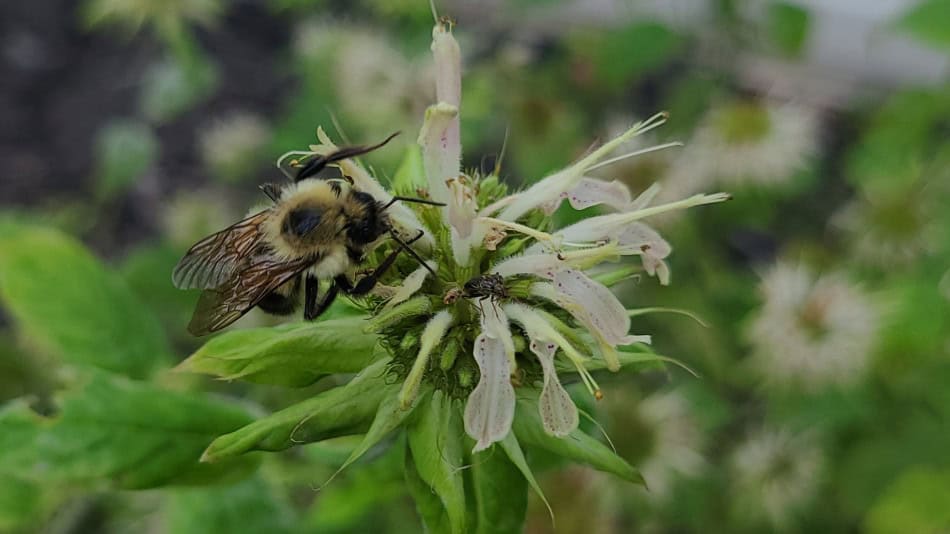
Deer and Rabbits
As a member of the Monarda genus, the foliage of this plant has a strong aroma when crushed/torn. And as such, this dissuades deer/rabbits from eating it.
Diseases
Like pretty much all bee balms, this one can catch powdery mildew. The disease is not fatal to the plant, and the effect is only cosmetic.
Where you can buy White Bee Balm
White Bee Balm is not typically sold in nurseries, as it isn’t a typical ‘garden friendly’ plant (spreads). But occasionally it can be purchased at specialty nurseries that deal in Native Plants. You can find native plant nurseries near you on our interactive map. If you happen to see it, pounce, as it is often ‘sold out’.
Where to buy seeds
Unfortunately I can’t recommend any sources for this plant. I had to forage my first seed head (responsibly). However there are some sources on ebay or etsy who will sell seed. I can’t vouch for them though.
Uses of White Bee Balm
Landscaping
White Bee Balm is a great plant for a woodland garden, rain garden, border, or even a formal native plant flowerbed assuming you take steps to control the spread (see my guide to stop plants spreading here). But there really isn’t a mystery to this one – plant it in growing conditions that it likes and the plant will take care of itself.
Companion Plants
White Bee Balm grows well with a number of plants that like similar growing conditions. Since it is a white flower, it can go with pretty much anything. I’ll give a list of flowers & their color that would grow well with it below, but don’t just go plant all of them together with White Bee Balm. Consider their colors and whether they would look good together, as you may not want red/purple flowers mingled with white bee balm!
I’m going to group them by color, so maybe focus on reds or blue/purples to contrast with that nice white/cream color of the bee balm.
- Red Bee Balm (red)
- Fire Pink (Red)
- Tall larkspur (dark purple to lavender)
- Bradbury’s Bee Balm (Lavender)
- Liatris Spicata / Blazingstar (pink/purple)
- Echinacea sp. (pink)
- Blue Lobelia (Blue)
- Eastern Blue Star (blue)
- Black Eyed Susan (yellow)
- Plains Sunflower (yellow)
- Marsh Marigold (yellow)
- Mountain Mint (white)
- Pale Penstemon (white)
- Foxglove Beardtongue (white)
Medicinal Uses
Numerous essential oils are contained within the leaves of White Bee Balm[6]. One in particular is beginning to look like it could be used in a number of treatments for various ailments ranging from asthma, diabetes, eczema, flu, high-blood pressure, and a number of other problems[7].
In addition to the aforementioned uses, Monarda clinopodia was used by the Cherokee to treat blood in the urine. It would be combined with Blue-stemmed Goldenrod to do so[9].
Botanical uses
The foliage of White Bee Balm contains numerous essential oils. Some of these contain anti-fungal properties and research has been undertaken to see if they can be used in combating damp-off disease[8].
Final Thoughts
If you are looking of a unique or rare plant that is beautiful, popular with pollinators, and native, then White Bee Balm is for you! Now it will come with a bit of maintenance in that it will spread via rhizomes, but this doesn’t take too much work and should only take 20 minutes each spring of pulling unwanted shoots. It may be hard to come by though, so ask around at gardening clubs and check your local native plant nurseries!
Find more native plants here
References:
[1] – Monarda clinopodia L. USDA NRCS.
[2] – Roedner, Beverly J., David A. Hamilton, and Keith E. Evans. Rare plants of the Ozark Plateau: a field identification guide. North Central Forest Experiment Station, Forest Service, US Department of Agriculture, 1978. Pages 62-63.
[3] – Whitten, W. Mark. “Pollination ecology of Monarda didyma, M. clinopodia, and hybrids (Lamiaceae) in the southern appalachian mountains.” American Journal of Botany 68.3 (1981): 435-442.
[4] – Missouri Species and Communities of Conservation Concern Checklist 2014, Missouri Department of Conservation. 2014 [link]
[5] – Vandevender, John. Monarda clinopodia L. Propagation Protocol Database. USDA NRCS – Appalachian Plant Materials Center. 2013
[6] – Pedersen, Jens A. “Distribution and taxonomic implications of some phenolics in the family Lamiaceae determined by ESR spectroscopy.” Biochemical systematics and Ecology 28.3 (2000): 229-253.
[7] – Khader M, Eckl PM. Thymoquinone: an emerging natural drug with a wide range of medical applications. Iran J Basic Med Sci. 2014 Dec;17(12):950-7. PMID: 25859298; PMCID: PMC4387230.
[8] – Gwinn, Kimberly D., et al. “Role of essential oils in control of Rhizoctonia damping-off in tomato with bioactive monarda herbage.” Phytopathology 100.5 (2010): 493-501.
[9] – Cozzo, David N. “Ethnobotanical classification system and medical ethnobotany of the Eastern Band of the Cherokee Indians.” (2004).
Recent Posts
Ok - so here is a little DIY Christmas gift for kids that is a lot of fun to make and shoot. A simple toy gun that shoots milk-jug caps...so that means ammo is free and you will never run...
Sweet Coneflower - A Complete Profile On Rudbeckia subtomentosa
Sweet Coneflower is a herbaceous perennial flower native to the Midwestern United States[1]. Scientifically known as Rudbeckia subtomentosa, it grows 3-5' tall in full sun and moist to medium-moist...
